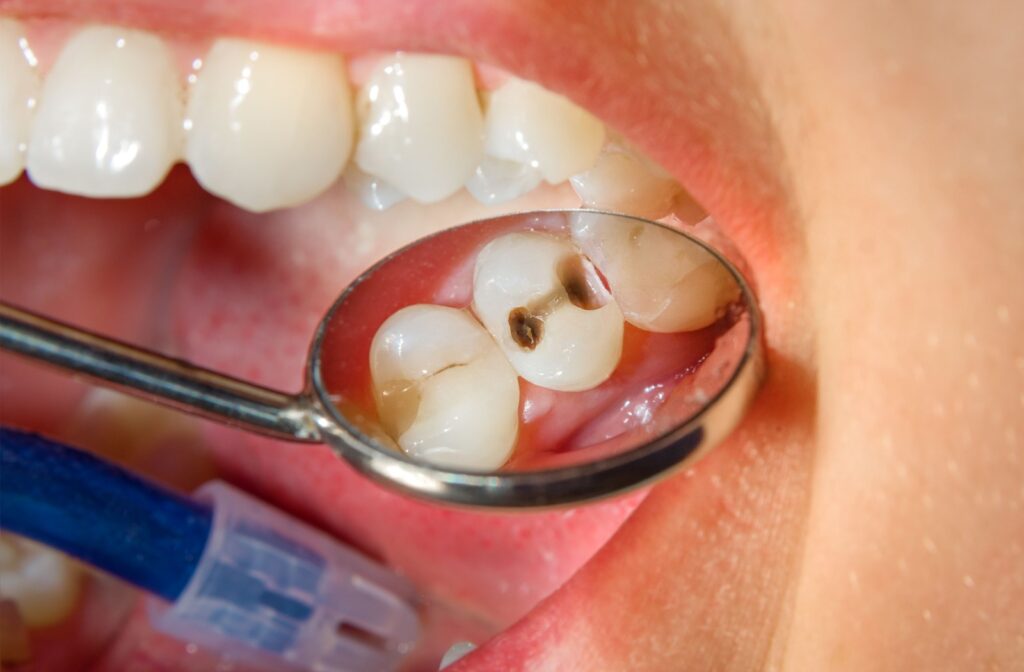When it comes to oral health, cavities are among the most common issues people face. But what exactly does a cavity look like?
For the average individual, you may not be able to tell a cavity by taking a look inside your mouth, that is where Kensington Dental Care steps in. Understanding the appearance, causes, treatment options and preventive measures can help you maintain a healthy smile.
At Kensington Dental Care, we are dedicated to assisting you in alleviating various dental problems, cavities included. While preventive care is key, if you suspect you might have a cavity, it is crucial to get a dental exam—let us help you find a solution.
What Is a Cavity?
A cavity, also known as tooth decay or dental caries, is a small hole that forms on the hard surface of a tooth. It occurs when bacteria in the mouth produce acids that gradually erode the enamel, the outer layer of the tooth. If left untreated, cavities can progress deeper into the tooth, leading to pain, infection, and even tooth loss.
What Does a Cavity Look Like?
Cavities can vary in appearance depending on their stage of development. In the early stages, a cavity may appear as a small white spot or discolouration on the surface of the tooth. As it progresses, the cavity may become darker in colour, ranging from light brown to black. In severe cases, the cavity may cause visible holes or pits in the tooth.
Causes of Cavities
Several factors contribute to the development of cavities, including:
Poor Oral Hygiene: Failing to brush and floss regularly allows plaque, a sticky film of bacteria, to build up on the teeth, leading to decay.
Diet: Consuming sugary and acidic foods and beverages can increase the risk of cavities by providing fuel for bacteria to produce acids that attack the teeth.
Dry Mouth: Saliva plays a crucial role in washing away food particles and neutralizing acids in the mouth. A lack of saliva, often caused by certain medications or medical conditions, can contribute to cavity formation.
Genetics: Some individuals may be more prone to cavities due to genetic factors that affect the strength and structure of their teeth.
Treatment Options
The treatment for cavities typically depends on the severity of the decay. Common treatment options include:
- Fillings: If the cavity is detected early, it can often be treated with a filling, which involves removing the decayed portion of the tooth and filling the space with a dental material such as composite resin or amalgam.
- Crowns: For more extensive decay or damage, a dental crown may be necessary to restore the tooth’s strength and appearance.
- Root Canal Therapy: If the decay has reached the innermost layer of the tooth, known as the pulp, root canal therapy may be required to remove the infected tissue and save the tooth.
- Extraction: In cases of severe decay or damage where the tooth cannot be saved, extraction may be the only option to prevent further complications.
Preventive Care
When it comes to issues with your teeth, prevention is always best! Preventing cavities begins with good oral hygiene habits:
- Brushing: Brush your teeth at least twice a day with fluoride toothpaste to remove plaque and bacteria.
- Flossing: Floss daily or every other day to clean between the teeth and along the gumline, where toothbrushes cannot reach.
- Healthy Diet: Limit sugary and acidic foods and beverages, and opt for tooth-friendly options like fruits, vegetables, and dairy products.
- Regular Dental Visits: Visit your dentist regularly for professional cleanings and checkups to detect and treat cavities early.

How Do You Know if You Have a Cavity?
While cavities often present with characteristic signs and symptoms, it is essential to consult a dentist for an accurate diagnosis. Some common indicators of cavities include:
- Tooth Sensitivity: Sensitivity to hot, cold, or sweet foods and beverages may indicate the presence of a cavity.
- Toothache: Persistent tooth pain, especially when biting down, could signal a cavity.
- Visible Discolouration: Changes in the colour or appearance of the tooth, such as white spots, stains, or visible holes, may indicate decay.
- Bad Breath: Chronic bad breath or an unpleasant taste in the mouth can result from the presence of cavities and bacteria.
Protecting Your Smile
Cavities are a prevalent dental issue that can have serious consequences if left untreated. By understanding what cavities look like, their causes, treatment options, and preventive measures, you can take proactive steps to maintain good oral health and a beautiful smile for years to come.
Remember to prioritize regular dental checkups and practice proper oral hygiene habits to keep cavities at bay. At Kensington Dental Care, your dentist can offer tailored advice to meet your unique requirements and make sure that you maintain a healthy, pain-free smile. Reach out to us and schedule your appointment today.










